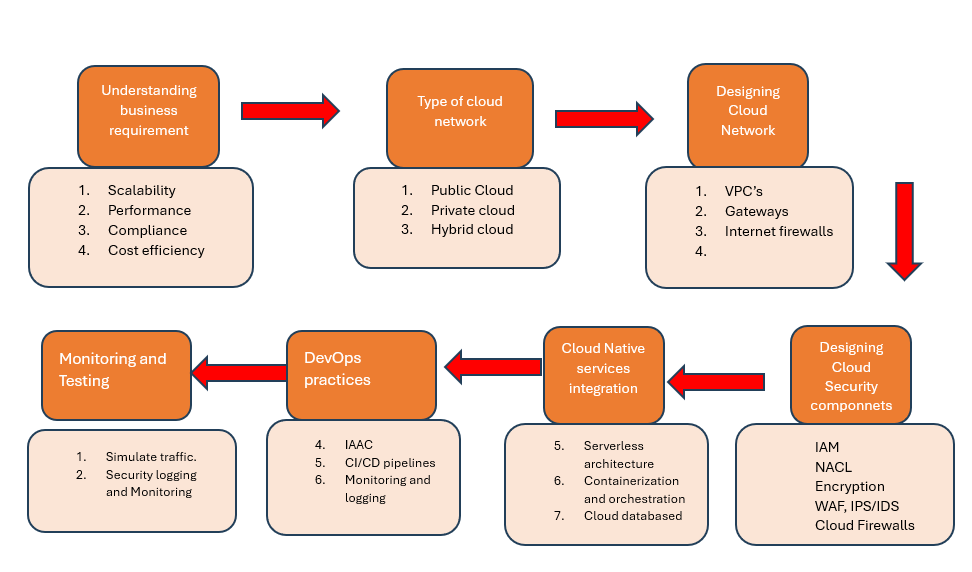Designing Cloud Networks
Designing a cloud network and architecture involves creating a scalable, secure, and efficient environment that leverages cloud infrastructure. Here’s a detailed step-by-step guide:
Our Methodology

Understand Business and Application Requirements
• Scalability: What’s the expected growth rate of users, data, or transactions?
• Performance: Latency, bandwidth, and speed requirements for applications.
• Compliance and Security: Regulatory standards (GDPR, HIPAA) that impact data storage and access.
• Cost Efficiency: Budget considerations, including operational expenses (OpEx) versus capital expenditures (CapEx).
Type of cloud Network
• Public Cloud: Hosted by third-party providers like AWS, Azure, or Google Cloud.
• Private Cloud: A dedicated cloud infrastructure hosted on-premises or by a third party.
• Hybrid Cloud: A mix of on-premises infrastructure and public cloud services.
• Multi-cloud: Using multiple cloud service providers (CSPs) for different tasks or as backup.
Design Cloud Network architecture
Cloud network architecture typically involves three key layers:
• Isolate Resources: Use VPCs to logically isolate cloud resources. Each VPC is like a mini network that contains virtual machines (VMs), databases, and other services.
• Subnets: Divide the VPC into multiple subnets—public (for internet-facing resources like web servers) and private (for internal services like databases).
• Routing Tables: Control the flow of traffic between subnets and from the VPC to the internet.
• Gateways:
o Internet Gateway: Enables internet access for public resources.
o NAT Gateway: Allows private resources to access the internet without being exposed to incoming traffic.
o VPN Gateway: For securely connecting on-premises resources with the cloud.
• Direct Connect / ExpressRoute: Dedicated connections between on-premises infrastructure and the cloud for better performance and security.
• Load Balancers: Distribute traffic across multiple instances for better performance and redundancy.
• DNS Services: Use managed DNS services (like AWS Route 53 or Azure DNS) for routing users to the right cloud services.
Cloud-native Services Integration
• Serverless Architectures: Leverage serverless computing (e.g., AWS Lambda, Azure Functions) to run code without provisioning or managing servers.
• Containers and Orchestration: Use services like Kubernetes (EKS on AWS, AKS on Azure, GKE on Google Cloud) for scalable, containerized applications.
• Cloud Databases: Use managed database services like RDS, DynamoDB, or Cloud SQL for easier scaling and management.
Cloud DevOps Practices
• Infrastructure as Code (IaC): Use tools like Terraform, CloudFormation (AWS), or Azure Resource Manager templates to define, provision, and manage cloud infrastructure programmatically.
• CI/CD Pipelines: Automate deployment pipelines using cloud-native tools like AWS CodePipeline, Azure DevOps, or Google Cloud Build.
• Monitoring and Logging: Implement continuous monitoring and logging to ensure that performance issues or security incidents are quickly identified and resolved.
Testing and Optimization
• Simulate Traffic: Use load testing to simulate real-world traffic patterns and ensure that the architecture can handle peak loads.
• Security Testing: Perform regular penetration testing and vulnerability assessments to ensure robust security.
• Performance Monitoring: Continuously monitor performance using cloud-native tools and adjust configurations for better performance and cost-efficiency.
Head Office - USA
16192 COASTAL HIGHWAY LEWES, DELAWARE 19958
business@techsiagus.com
Regional office - Dubai - UAE
business@techsiagus.com
Regional office - Pakistan
business@techsiagus.com

